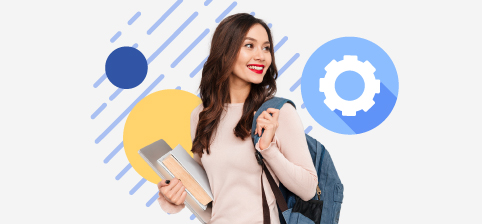Co-contributors:
Michael Mast, Business Development Manager, Technology, E&I
Ken Chapman, VP of Learning Innovation Advocacy, D2L
Lisa Neu, Enterprise Account Executive for Higher Education, Talend
Bruce Ottomano, Director of Business Development, Passerelle
Rob Curtin, Director, Higher Education, Microsoft
Jesus Trujillo Gomez, Senior Strategic Business Executive, Google
Kate Parker, Vice President, Higher Ed Content Services, LearningMate
Angela Vann, Learning Design, Strategist, LearningMate
Trevor Kelly, Principal Solution Consultant, Genesys
Khalil Yazdi, Resident EdTech CIO, Carahsoft
Today, educators and institutions have the unique challenge of leveraging modern digital technology to enhance and personalize the student experience. To build a student-centric relationship between an institution and its student body, educators must take the student’s view into perspective and question whether they are gaining a cohesive yet diverse experience engaging with their school. At EdTech Talks 2022, speakers provided recommendations to improve the student experience by mitigating these challenges and realizing the importance of integrating, analyzing and using data effectively and responsibly.
What’s Possible in the “New Now”: Why the Student Experience Matters
The 2022 Top 10 IT Issues stated, “Successfully moving along the path from vision to sustainability involves recognizing that no institution can be successful and sustainable without placing students’ success at the center, which includes understanding how and why to equitably incorporate technology into learning and the student experience.” Panelists articulated what this means to them and the role of technology in the student experience through various insights:
- A one size fits all experience for students does not work. Through technology and data, institutions can shift the approach to education design and delivery at scale to extend the abilities of educators to reach and inspire students.
- Institutions should have a platform that facilitates identifying a holistic view of the student body to allow staff to create personalized pathways for success with their students. Additionally, utilizing data analytics in a comprehensive view can distill valuable recommendations for students to remain on track.
- With a plethora of student data collected, the challenge becomes unlocking the value of that data to pinpoint those personalized experiences and increase retention rates. In the higher education space, there is a pattern to collected data that a university can use to improve a student’s education journey and network relationship after graduation.
- Students currently have higher expectations of their institutions’ technology, lifestyle and learning goals and brand experience. Schools need to continuously let their data guide changes for improved engagement and growth of their community.
 Utilizing Core IT Systems to Build a Better Student Experience
Utilizing Core IT Systems to Build a Better Student Experience
Infrastructure platforms such as learning management systems (LMS) should enable students and instructors to have an efficient, organized and interoperable experience. By adopting a single hub space to support connectivity among community members, administrators can ease accessibility issues, learn from instructor best practices, understand the most successful methods for creating consistency and give students the ability to personalize their experience on their pathway to successful learning.
These data observations within educational IT systems promote a better comprehension of how to drive diverse learner engagement. With most assignments, content and homework now migrated to cloud environments and digital workspaces, instructors have practical insights into student engagement and work patterns. For example, teachers and professors can see who students collaborate with, how often they work on a particular document, how many edits are made before final review, etc. Core system data analysis can allow institutions to empower students in their experiences whether in the classroom or a remote learning environment.
Maximizing Quality Data
Finding and comprehending intelligent data regarding all students across a campus is essential to creating a rich learning environment, but this process is also taxing. Institutions should plan to implement these four steps to aid in data progress:
- Effectively assemble student information and other systems data
- Master data to ensure trusted results
- Utilize a third party to enrich the quality of data and gain a broader view of students or alumni
- Analyze relevant findings and implement actionable steps across campus
When addressing these elements, data overload can also be an issue. Data governance is critical for finding, securing and applying the right data to discover important insights about schools’ communities. Institutions should not allow everyone access to raw data because the sheer quantity of information can create confusion and only knowledgeable users will be able to fully discern relevant data. Instead, data stewards and analysts should present specialized views of the appropriate data to individual audiences, giving that data new quality.
When developing a holistic view of students, data isn’t the only solution. Sometimes the most effective technique to understanding each individual in a data-driven culture is to create spaces to audibly listen to their views, note their academic and personal reflections, create multiple points of calibrating their reactions and feedback, etc. Not only do students feel more heard, but also the educational changes that derive from these interactions create a strong positive outcome.
Addressing Learning Loss, Accessibility and Student Success
Fueled by the pandemic, the U.S. has seen a dramatic increase in learning loss. Math and reading scores have plummeted and students have been severely impacted by the challenges that come with the hybrid learning environment. Additionally, the significant shortage of teaching staff and, therefore, consistent instructional content and operations in the K-12 domain, has negatively impacted engagement and learning success.
Technology solutions should meet the needs of students rather than hinder their ability to learn. Institutions can benefit from an integrated digital platform through which its instructors can proactively analyze data about their students. This way, schools support various types of learners to maximize their achievement in the classroom and help reduce the variability of remote learning. Online learning is here to stay, and it is the responsibility of schools to provide the updated digital infrastructure and accessibility, as well as first-rate IT support and communication needed for this new era of education.
Contributing experts from E&I Cooperative Services, Talend, D2L, Passerelle, Microsoft, Google, LearningMate and Genesys can support your student experience initiatives by breaking down barriers to student success and steering digital transformation efforts in the right direction. Visit Carahsoft’s EdTech Talks 2022 resource center to view their on-demand recordings and learn more about the featured education technology providers.
*The information contained in this blog has been written based off the thought-leadership discussions presented by speakers at Carahsoft’s EdTech Talk Series 2022.*








